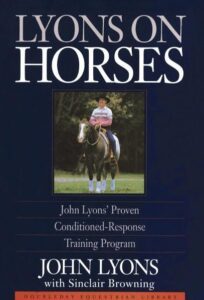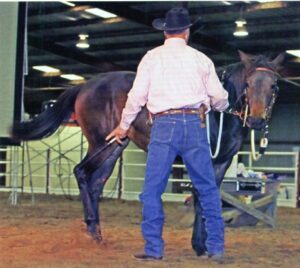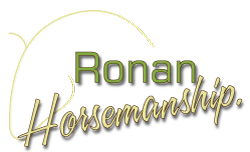
John Lyons understands the mechanics of NH (Natural Horsemanship) but has no feeling with horses, he is not able to communicate with horses _ which is the big difference with Tom Dorrance for instance. John Lyons’ understanding of horses is purely mechanic: horses are binary animals, unable to think or feel, unable to understand.
All his program is based on conditioning a horse to give one specific response to one specific cue:
“If we set up the condition often enough, and we get the same response consistently, then the condition becomes a cue for a specific, desired reaction or response.Lyons on Horses, John Lyons
NH Core
The horseman clearly declares his will to become a partner to the horse, to let time to the horse in order to process the cues we want to teach them. He also uses the known principle of pressure and release. We can also positively consider his three training rules, which remain good for any method: training must be safe for the horseman or the horsewoman, training must be safe for the horse, and the horse must be calmer after the lesson than before. I liked to read his saying about the step by step learning process and how we should “cultivate patience, and always remember to give the horse the benefit of the doubt.” John Lyons also talks about feel in his own way when he mentions our “subconscious movement” that actually becomes a cue to the horse . . .
John Lyons program limits
This method could be compared to the Australian horsemanship as introduced by Clinton Anderson. Indeed, both consider horses as robot-animals, things that can not feel, just react to cues given by superior minds that the horseman is supposed to be. Although at least, in my opinion, Clinton Anderson has done a better work in breaking exercises down into segments. He did not fall into contradictions and was able to develop a clear and simple method. Hereunder is a couple of examples to illustrate the limits of the program proposed by John Lyons.
 Pre-cues, cues, and enforcers
Pre-cues, cues, and enforcers
Here, we can read that John Lyons understood the key-principle of making the right thing easy and the wrong thing difficult. Yet, it also appears clearly that he has some problems to make it simple. He gives us the example of the trot that is composed of six different steps!
1 ) First pre-cue is “raising our hands forward”,
2 ) Second pre-cue is “standing up in the saddle and leaning forward”,
3 ) Third pre-cue is “kissing to the horse”,
4 ) First cue is “a light squeeze with both legs”,
5 ) Second cue is “bumping the horse with both legs”,
6 ) Finally, the enforcer is “a hard kick with both spurs”!
This method can not be really efficient and there is the problem of violence (hard kick, spurs).
 Advanced exercises
Advanced exercises
The lack of efficiency becomes clear when we start to deal with more advanced exercises, such as choosing the good lead at the canter. That sequence is broken down into five or six segments, the first three being supposed to close the deal with 95% of the horses. You should add another two to three segments for the last 5%, depending how difficult they are to manage. We would have liked a simple method: first soft deal, second firm deal, efficient with 100% of the horses!
Not so horseman-like
Taking into account how recognized a horseman John Lyons is, some pages actually scared me.
 History
History
Lyons On Horses, John Lyons
 Contradictions
Contradictions
I noticed a few lines in the book that can also be quite embarrassing for a horseman:
- Cue to back up – “Both of the rider’s feet are brought forward and the rider’s toes are wiggled back and forth on the horse’s elbows.”
Putting pressure by squeezing the legs or feet is the most obvious cue to move a horse forward. It is then completely illogical to put pressure on the horse to ask it to back up. - Picking the leg – “If he begins to kick, […] stand up and pet him.”
Petting a horse is a reward to it. So, petting your horse when it kicks is teaching it to kick every time you want to pick up a leg. - Cue to move forward – “If a horse kicks during the tapping, I usually don’t reprimand him”, says John Lyons. But then he adds that if the kicking becomes unpleasant (is there any pleasant kicking?), we should “whack the horse […], once for every kick.” One more time, this method lacks clear information for the horse. Kicking is kicking, there is no low kicking that could be accepted against hard kicking that should be forbidden. A partner horse never kicks!
- Loading – “When the horse stops, we stop. And we pet him.”
That is another good example of teaching a horse the contrary of the expected result. If we want our horse to move toward the trailer, petting it when it stops teaches to stop and avoid the said trailer.
 Violence
Violence
Lyons On Horses, John Lyons
As a conclusion, I think this violence and all the nonsense are enough to discredit John Lyons as a horse whisperer. No real gentle horseman can advise murder and pain against horses. He studied natural horsemanship on the surface and applied the technics to his training method, efficient but insensitive. He is one of those horse(business)men who use NH as a marketing tool to sell books, clinics and other videos. My personal advice: do not read John Lyons unless you are already well informed about Natural Horsemanship principles and philosophy, said knowledge being necessary to extract the interesting and non-abusive content of the book.


 ENGLISH
ENGLISH DEUTSCH
DEUTSCH ESPAÑOL
ESPAÑOL FRANÇAIS
FRANÇAIS